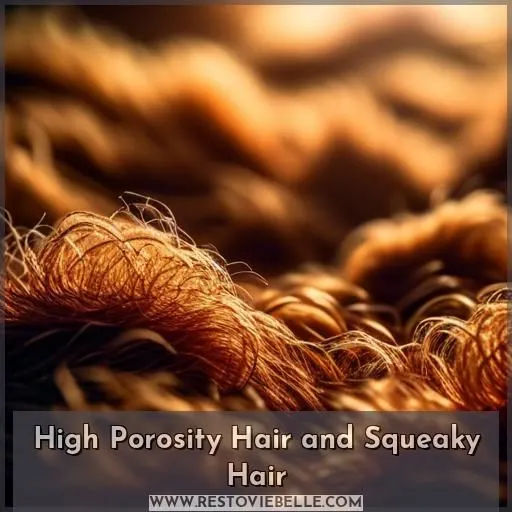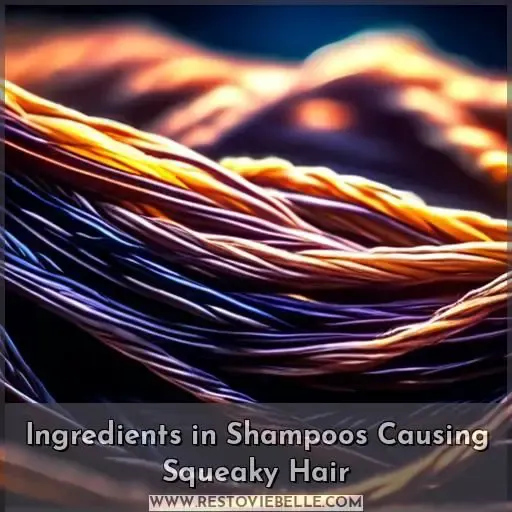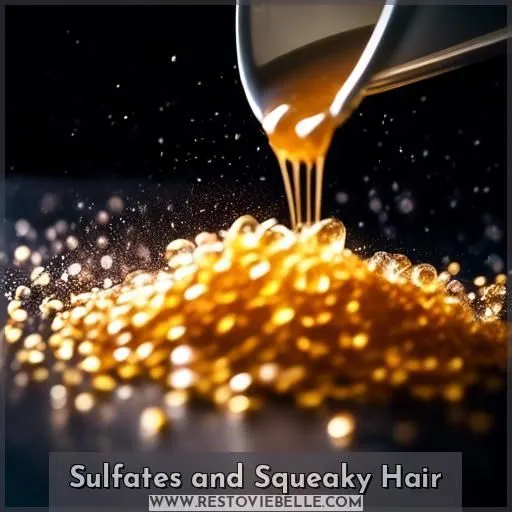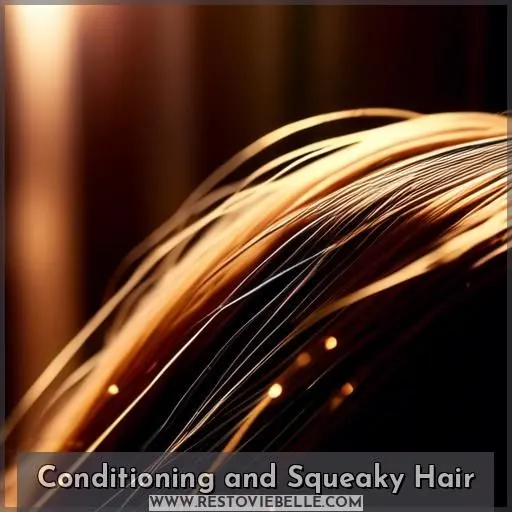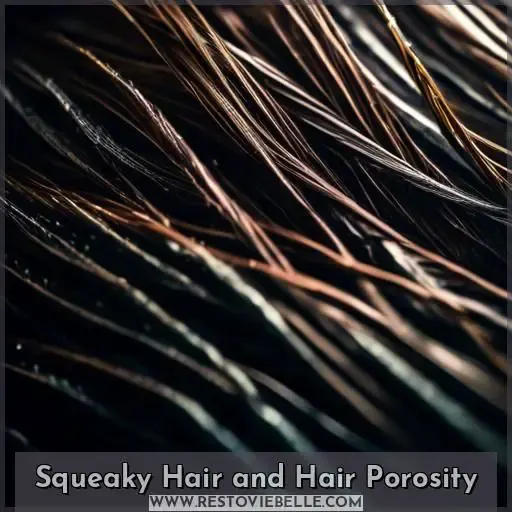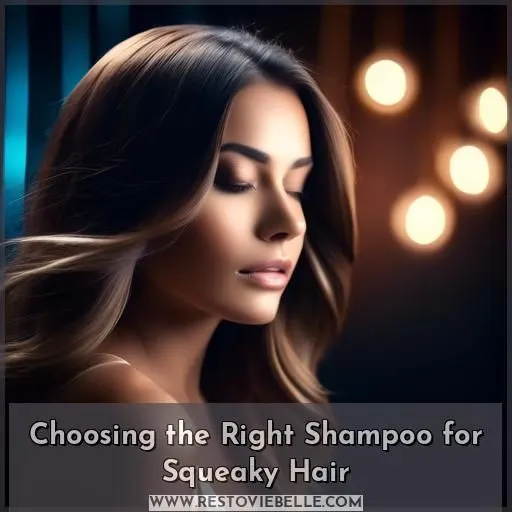This site is supported by our readers. We may earn a commission, at no cost to you, if you purchase through links.
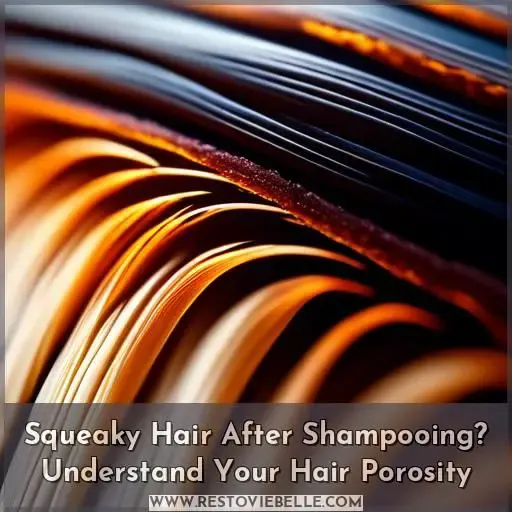
If your hair feels squeaky after shampooing, it’s likely due to your hair’s high porosity. High porosity hair has open cuticles that allow for easy moisture absorption and evaporation, leaving your strands feeling dry and squeaky.
This can happen when your shampoo contains harsh ingredients like sodium lauryl sulfoacetate (SLSA) or sulfates, which can strip away your hair’s natural oils.
To combat squeaky hair, focus on deep conditioning regularly and using a sulfate-free shampoo. Additionally, following the Liquid-Oil-Cream (LOC) method can help restore softness and manageability.
By understanding your hair’s porosity and using the right products, you can address the issue of squeaky hair.
Table Of Contents
- Key Takeaways
- Why Does My Hair Feel Squeaky After Shampooing?
- High Porosity Hair and Squeaky Hair
- Ingredients in Shampoos Causing Squeaky Hair
- Sulfates and Squeaky Hair
- Conditioning and Squeaky Hair
- Squeaky Hair and Hair Porosity
- Choosing the Right Shampoo for Squeaky Hair
- Frequently Asked Questions (FAQs)
- Conclusion
Key Takeaways
- High porosity hair, characterized by open cuticles, can result in squeaky hair due to easy moisture absorption and evaporation.
- Sulfates and harsh ingredients in shampoos can strip away natural oils, leading to squeaky hair.
- Regular deep conditioning and using sulfate-free shampoos can help combat squeaky hair.
- The Liquid-Oil-Cream (LOC) method can help seal in moisture and protect high porosity hair from damage.
Why Does My Hair Feel Squeaky After Shampooing?
The squeaky feeling in your hair after shampooing can be attributed to the removal of oils and build-up from your hair. This is especially common when you switch to a new shampoo that’s more clarifying, which can strip your hair of natural oils and leave it feeling dry.
The squeaky sensation is a result of the cuticle layer of your hair being raised, which can make your hair more prone to damage due to increased friction.
To counteract this, it’s imperative to use a conditioner and a leave-in conditioner to restore moisture and smoothness to your hair.
High Porosity Hair and Squeaky Hair
High porosity hair is characterized by open cuticles, which allow for easy absorption of moisture but also lead to quick evaporation. This can result in a need for frequent remoisturizing and a susceptibility to damage.
To address these concerns, high porosity hair benefits from protein treatments that fill in cuticle gaps, improve elasticity, and reduce breakage. Additionally, the LOC method, which involves layering liquid, oil, and cream, can help seal in moisture and protect the hair from damage.
Acidic rinses can also be beneficial for high porosity hair, as they can help seal the cuticle and lock in nutrients. It’s essential to avoid over-processing and protect the hair from heat damage.
Ingredients in Shampoos Causing Squeaky Hair
Shampoo’s components can have a considerable effect on your hair’s texture, such as the feeling of squeaky cleanliness. Cleaning agents like sodium lauryl sulfoacetate (SLSA) are often found in shampoos to create a thick lather. However, some people may discover that these ingredients irritate their skin or leave their hair feeling squeaky.
To deal with this, consider using shampoos with milder cleaning agents like decyl glucoside, which is a non-irritating surfactant. Some individuals also prefer shampoos that are SLS-free or apple cider vinegar shampoos, which may offer a different cleansing experience and aid in maintaining hair volume.
When selecting shampoos, always give priority to the safety of the ingredients and the clarity of the product to preserve the health of your scalp and hair.
Sulfates and Squeaky Hair
Sulfates, which are strong detergents found in various beauty products, can have a negative impact on hair’s health. They can leave strands dry and brittle, as they target oils and dirt. In the context of hair porosity, sulfates can cause color fade by penetrating the hair’s cuticle, stripping natural oils, and drying out the hair. However, not all sulfates are equally damaging. Those ending in yl, such as sodium lauryl sulfate (SLS), are considered harsher, while those ending in -eth, like sodium laureth sulfate (SLES) or mild sulfates, may not cause color fade if used in small volumes.
To address this issue, some individuals with high porosity hair opt for sulfate-free shampoos, which can help reduce color fade and improve moisture retention. Cream-based sulfate-free shampoos are particularly recommended for high porosity hair, as they help fill in the gaps in the hair cuticle, which is essential for highly porous hair.
When choosing shampoos, it’s essential to take into account your hair’s porosity and sensitivity to sulfates. Low porosity hair may benefit from sulfates, as they help cleanse the hair more effectively and prevent build-up. However, if you have high porosity hair, you may find that sulfate-free shampoos are milder on your hair and better suited to your needs.
Conditioning and Squeaky Hair
Maintaining the Health of High Porosity Hair
Conditioning your hair is vital in preserving its well-being, particularly for high porosity hair. High porosity hair features more extensive cuticle gaps, permitting moisture to penetrate effortlessly but also making it vulnerable to rapid moisture loss. To guarantee your hair remains hydrated and robust, adhere to these suggestions:
- Deep condition regularly: High porosity hair thrives on deep conditioning treatments that can infiltrate the hair shaft and confer long-lasting moisture.
- Employ cream-based leave-ins: After deep conditioning, utilize cream-based leave-ins to aid in moisture retention and shield the hair from moisture in the air.
- Avoid excessive washing: High porosity hair has a tendency to dehydrate more readily, so refrain from washing it too often.
- Handle with care during styling: High porosity hair is more prone to damage, so exercise gentleness when styling and limit the use of heat tools.
- Opt for a sulfate-free shampoo: Sulfates can deplete the hair of its natural oils, rendering it more susceptible to damage and dryness. Select sulfate-free shampoos that incorporate nourishing ingredients like coconut oil and argan oil.
Squeaky Hair and Hair Porosity
Understanding your hair porosity is essential when dealing with squeaky hair after shampooing. High porosity hair, which can be identified through the water test, strand test, or squeak test, is prone to damage and requires protein treatments and the LOC method to seal in moisture.
Low porosity hair, on the other hand, is more resistant to damage and benefits from heat and steam for deep conditioning.
By knowing your hair’s porosity, you can tailor your hair care routine to maintain its health and appearance.
Choosing the Right Shampoo for Squeaky Hair
Are you frustrated by the squeaky feeling in your hair after shampooing? Understanding your hair’s porosity can help you choose the right shampoo and adopt effective hair care tips to address this issue. Testing your hair porosity and selecting products designed for your needs can transform your squeaky hair into soft, manageable locks.
Porosity Testing
Diving into porosity testing, think of it as your hair’s secret handshake with moisture. The strand, water, and squeak tests are your trio of detectives, uncovering whether your locks are high-fiving moisture or giving it the cold shoulder. It’s like playing detective in your own bathroom – a small investigation that leads to mastering the mystery of your mane’s needs.
Hair Care Tips
To choose the right shampoo for your hair, consider your hair texture and porosity. Low porosity hair may benefit from a shampoo that penetrates easily, while high porosity hair may require a protein-rich formula to fill in cuticle gaps.
Medium porosity hair typically absorbs and retains moisture well, so a gentle, sulfate-free shampoo may be suitable.
Always read ingredient lists and choose products that align with your hair health and styling goals.
Product Recommendations
To choose the right shampoo for squeaky hair, consider your hair’s porosity. High-porosity hair tends to be more prone to porosity issues, resulting in squeaky hair. To address this, look for shampoos with moisturizing ingredients like glycerin, shea butter, or natural oils (e.g., coconut, argan, jojoba) to hydrate and nourish your hair. Opt for sulfate-free formulas, as sulfates can strip moisture from high-porosity hair, making it even drier.
When selecting shampoos, consider the following tips:
- Protein Balance: High-porosity hair may benefit from protein treatments, but be cautious not to overdo it, as excessive protein can lead to brittleness. Look for balanced formulas.
- pH-Balanced: A pH-balanced shampoo helps to seal the hair cuticles, reducing frizz and preventing further moisture loss.
- Repair and Strengthen: Choose shampoos designed to repair and strengthen damaged hair, often containing ingredients like keratin or biotin.
- Product Reviews: Read reviews and recommendations from individuals with high-porosity hair to find shampoos that have worked well for them.
- Trial and Observation: It may take some trial and error to find the perfect shampoo for your hair. Pay attention to how your hair responds over time.
- Consider Your Hair’s Specific Needs: High-porosity hair can vary in its needs. For instance, if your hair is also curly, look for shampoos designed for curly high-porosity hair.
For those seeking natural hair care with fewer chemicals, consider products from a Canadian company. When purchasing, verify that the products are ethically sourced, supporting sustainable practices and fair treatment of workers involved in the production process.
Frequently Asked Questions (FAQs)
How does water hardness affect squeaky hair?
Yo, the hardness of your tap water can totally make your hair feel like it’s squeaking after shampooing. Hard water’s got lots of minerals that can leave a residue, making your strands feel rough and dried out.
Can diet influence hair porosity and squeakiness?
Your diet plays a pivotal role in hair porosity and squeakiness. Nutrient deficiencies, like lack of protein or healthy fats, can lead to dry, brittle strands that feel squeaky after washing. Stay hydrated and eat a balanced diet for luscious locks.
Are there any natural remedies for squeaky hair?
For squeaky hair, try using a Apple Cider Vinegar rinse – it’ll help balance your hair’s pH and close the cuticle. Massage in some coconut or argan oil too for extra moisture and shine. Easy, natural solutions to tame that squeak!
How does seasonal change impact hair squeakiness?
Seasonal shifts sway squeakiness, savvy searcher. Shifting seasons stir strands, stoking strife. Springtime surges, summer scorches, autumn alleviates, winter whispers. Manage moisture, mitigate mayhem with mindful maintenance, and your hair will happily harmonize.
Can brushing techniques reduce hair squeakiness?
Absolutely, your brushing technique can impact that squeaky sensation. Gentle, minimal brushing helps maintain the hair’s natural oils and pH, minimizing that stripped, squeaky feel after shampooing. Just be sure to choose a soft, boar bristle brush.
Conclusion
Remarkably, up to 80% of people experience squeaky hair after shampooing due to high hair porosity. To address this, you should focus on using sulfate-free shampoos and deep conditioning regularly.
By understanding your hair’s porosity and following the Liquid-Oil-Cream method, you can restore softness and manageability to your squeaky hair.
Ultimately, addressing the root cause of why your hair feels squeaky after shampooing is key to resolving this common issue.
